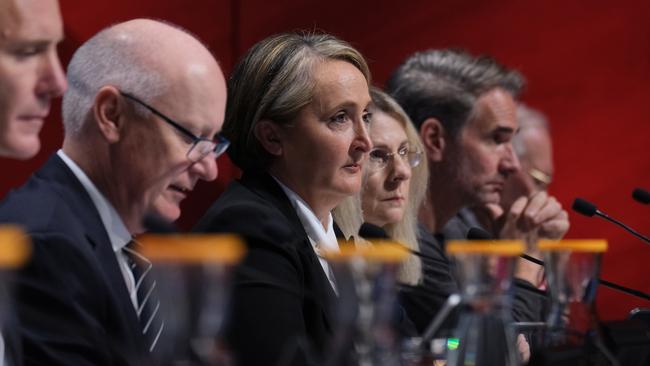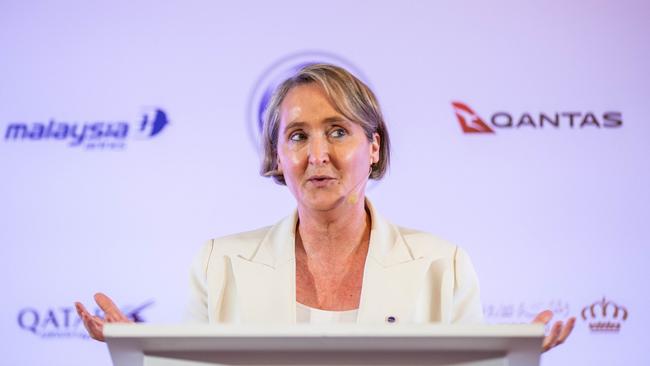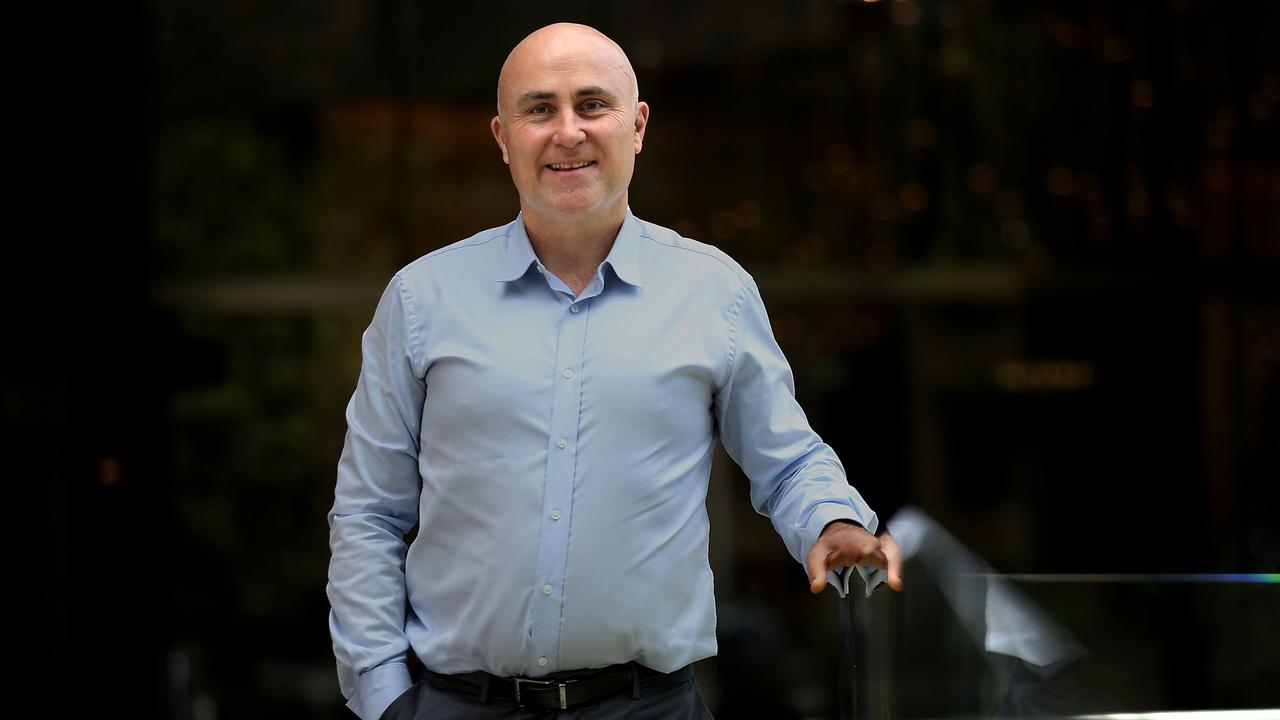Alan Joyce power at Qantas and bonus structure led to mistakes inside weak boardroom
A forensic look at Qantas’s failings finds the overriding theme was a dominant, long-term CEO who called all the shots in the face of a weak board.

Business
Don't miss out on the headlines from Business. Followed categories will be added to My News.
As former Telstra chair John Mullen prepares to take over as chair of Qantas, he at least has a starting point. A revealing guide into the big mistakes made by the airline’s boardroom that lead to last October’s reputational implosion.
Running through a forensic review of Qantas’s failings the overriding theme is that of a dominant, long-term chief executive – former boss Alan Joyce – who called the shots around the board table and through the airline’s management ranks. The document doesn’t mention Joyce by name but he is there.
Joyce, a highly experienced CEO, dominated all parts of the airline with a “command and control” leadership style. Worryingly, Qantas directors were all captured by him.
And this means the board, led by long-term chair Richard Goyder, was prepared to focus on the good news Joyce was delivering while fundamentally failing to recognise the damage being done.

However, Qantas’s mistakes began in the boardroom and this means not all can be sheeted back to Joyce, who now faces more than $9m being stripped from his final year’s pa.
Indeed it is arguable that Joyce was focused on single-mindedly delivering the strategic and financial targets he had been generously incentivised to chase.
So too, a weak board allowed the long-serving CEO to call the shots. Goyder has brought forward his planned exit from November to mid-next month.
Mullen tells The Australian there were failures but no one started out with the plan to do the wrong thing. The review has the luxury of retrospect.
“It’s clear that the company board and management made some mistakes and let Australians down,” Mullen says in an interview.
“I would put them in the context of a lot of very successful years as well, particularly keeping the airline alive through Covid-19, which I think board, management, the CEO and chair did an extremely good job. That said you’re charged with the overall reputation and governance of an organisation. And clearly there were failures.”
Joyce was chief executive for 15 years and even though he had the backing of the board, clearly overstayed his welcome. Although the Covid-19 pandemic extended his tenure by interrupting succession planning, by the end the hits were piling up.
Lost luggage, delays, the ACCC’s $100m “ghost flight” action and a High Court challenge against sacked workers.
Following the reputational implosion of last year outgoing chair Goyder appointed retired McKinsey partner Tom Saar to undertake a deep dive into what went wrong inside the Qantas boardroom. All up he came up with 32 recommendations for change. Many of these including remuneration have been acted on.
These are the five key takeouts and the findings should be studied by all boards.
Powerful CEO
There was too much deference to Joyce, who held the role for 15 years, and spent more than two decades with the airline. He was a highly experienced CEO who through his time at the airline (and through multiple chairs) overcame several major operational and financial crises. Think the grounding of the fleet to take on unions, the global financial crisis or the Avian flu crisis that swept Asia in the years that followed.

This added to Joyce’s power base and often resulted in the CEO having command of the boardroom where discussion around the board table didn’t involve robust challenge of management or debate. As part of this, Joyce also controlled the information flow. The board too didn’t always get visibility on some issues earlier for input. On many issues there was a failure to probe management on options and risks.
The Covid-19 pandemic was an extreme shock for Qantas, which put the airline in a position where it was facing a real risk of administration. The pandemic also pushed back the succession planning, although it should be noted Joyce was already 12 years into the role by the time it hit. This was already double the average tenure of a chief executive for Australian listed companies.
Reopening vs operational
Qantas’s board was on high alert during the Covid-19 crisis, meeting almost twice a month through to 2021.
The focus was on safely restarting the operations. Indeed the mindset of re-opening soon became a “business as usual” function rather than an extraordinary event and the responsibility for this was soon delegated to management.

As a result, the Qantas board was too reactive in its responses and could have more actively sought information regarding the developing operational and customer difficulties. There were no leading indicators or customer data flowing to the board about the impact contentious decisions such as Covid credits, pricing and cancellations were having on the airline’s reputation.
All on same page
With a number of long-term directors, the approach inside the Qantas board became too collegiate and comfortable.
Whether this was the prevailing culture of the boardroom style under Goyder – or even if there was genuine agreement – directors didn’t speak out enough.
This suggests the selection of directors had become too uniform or they were not suited for the job. There is a risk of “collegiate boards” settling in when things are going well for businesses and it’s the role of the chair to be on top of this. This was even more problematic for Qantas, given things clearly weren’t going well at the airline.

As part of this was an admission that support of high-profile social campaigns like backing for the Indigenous voice wasn’t tested by the board. Nor was there a framework to consider how the issues like the voice were consistent with the broader Qantas strategy.
Good management thrives on a diversity of opinions and having directors who engage in fair debate and challenge convention.
Profit is king
Like management, the mindset inside the board was a focus on financial, commercial and strategic outcomes. This came at a cost of non-financial issues such as employees, customers and other stakeholders.
Ultimately this is where the reputational damage started to set in.
Too much of Qantas’s short-term bonus structures were based around cash over shares. So too there was too much discretion on rewarding individual performance over company-wide performance in paying bonuses, which is not best practice.
Qantas has since reweighted management bonus settings to non-financial risks with particular focus on operational reliability, customer or employee issues.
Directors too need to be reminded to take a wider lens.
Cultural blind spot
Leadership culture was found to be part of the root cause driving the airline’s reputational hits.
Qantas suffered from a “command and control” leadership style under Joyce with centralised decision making.
This contributed to a top-down culture, which impacted a willingness of staff to challenge or speak up on issues or decisions of concern except in relation to safety matters. The board allowed this environment to flourish.
Inside the boardroom there were limited formal reporting or analysis of group culture beyond safety reporting. Indeed, the Qantas directors increasingly saw a top-to-bottom “safety culture” as representative of the airline’s entire culture. Here the executive pay structure was silent on the development of corporate culture.
For board members there were not enough informal forums to gauge views from staff, and a reluctance of directors to really look under the bonnet into what was going on inside the airline.
Looking ahead
For investors, customers, employees and others – what will change at Qantas under Mullen?
The former Asciano chief and Telstra chair says the board review, as difficult as it was, is a good foundation.
“It’s uncomfortable reading, and nobody’s proud of reading that about themselves, but it’s the right way to do it. It’s setting the base for fixing those issues.
“There should have been a lot more scrutiny, a lot more board involvement, a lot more challenging of those decisions before they went ahead with them”.
Many changes particularly, around resetting remuneration and the message around it, have already been made. Joyce had his pay docked by $9.2m and the current and former executives (including chief executive Vanessa Hudson) had short-term bonuses docked by a third.
Mullen is already talking around board renewal, even with half of the board now new appointments, including himself.

And what about managing dominant CEOs? Having the right remuneration settings in place are imperative, Mullen says. But the executive in charge needs to take a broader view beyond the financial scorecard.
“With the role of the CEO comes a responsibility to think outside the box as well. In reality as a CEO there are probably 100 metrics that you’ve got to pay attention to in running a business.
“The board should be challenging that all the time to say the CEO has hit the numbers, but what about the pub test now?
“We were a little short on that during this last year”
Originally published as Alan Joyce power at Qantas and bonus structure led to mistakes inside weak boardroom





